Cobra La lalalalalala!
So on the way to Mahabs the other week, we went to the Madras Crocodile Bank . It was originally set up as a conservation and research site for India's three varieties of endangered crocodiles, and since it has expanded to a herp research centre. They do work on sea turtle conservation and wildlife conservation in the Andaman and Nicobar Islands. They work on producing anti-venom for four of India's most deadly snakes.
The snake section of the Croc Bank has been set up and is maintained by the Irulas, a scheduled caste/tribal community that has historically lived quite separate lives from their neighbours in the forests of Tamil Nadu and who were primarily employed with snake and rat catching, and the hunting/gathering and sale of forest product (firewood, honey, beeswax etc.).
In 1976, the Indian Government signed the Forest Protection Act, which made their villages and livelihoods illegal. Since then, some terrible injustices have been made upon the Irula people as they have struggled to make a new way of life. Generations of some families have worked inside rice mills in slave labour and terrible conditions, while others have starved or died in desolation and hunger, and still others defy the government mandate and continue their traditional way of life in the forest.
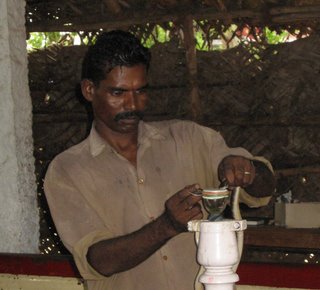
In that context, Croc Bank, is an especially fascinating endeavour. In the snake venom extraction area of Croc Bank, you can witness the generations of expertise in working with deadly snakes, as they nonchalantly milk kraits of their venom (the process doesn't hurt the snake) or lift deadly cobras out of clay pots. "He bite, two days you die." the snake handler assured us as he held up the cobra and laid it gently on a platform in front of him. Withdrawing the home-made hooked tool he was lifting the snake with, he began to wave his bare hand in front of the cobra as it reared up and coiled it's hood, grinning wryly and unafraid as the gathered onlookers winced in fear.
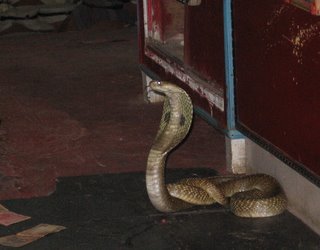
He shows us several varieties of cobras and crakes, rejoicing in telling us how quickly the reptiles could kill us, while deftly manoeuvring his flesh just barely out of reach of the snake's fangs. The last one, the saw-scaled viper, a tiny little garter snake looking thing wrapped around his hand. He grins toothily as he says; "Just two hours. Two hours you die."
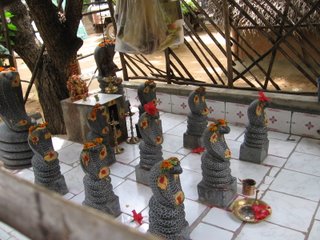
Like everywhere in India, if you just have a glimpse around a corner, there's a temple, and outside the snake venom extraction centre is no exception. There, a little tiled snake shrine, with freshly sandalwood and vermillion pasted carved cobra idols, and a small Ganesh to watch over the industrious endeavours of the park.
Of course, snakes aren't all you can see. The Croc Bank is home to more than a dozen species of endangered and non-endangered turtles, including soft shelled temple turtles who blend down into the sand at the bottom of their tanks,
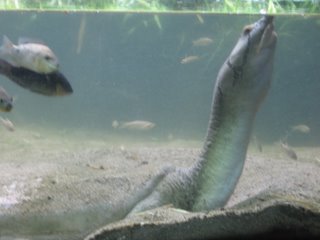
and those that move so slowly that the algae that grows on their backs serve as an extremely slow moving buffet for the fish in their ecosystems.
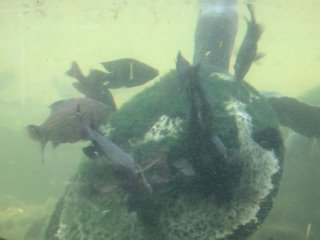
We also saw komodo dragons and monitor lizards and at least a dozen varieties of crocodiles: caiman from the Amazon, American, and many local gharials and muggers. Each of the different areas had information signs up with a list of pictures that made up the diet of the croc in question, and you knew when you came across one with a picture of a bull, that you were dealing with a serious croc. The mugger is the biggest man-eating beast in all of India, and while they're kind of cute when they are babies:
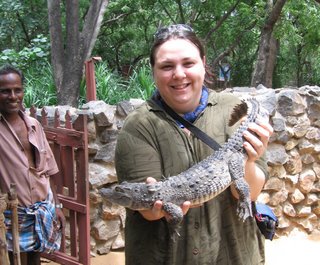
Even if they do squirm a lot (and are capable of taking off your fingers if you put your hands in an inopportune spot!). But once they are all grown up, they are entirely deadly, and can jump, surprising distances. This full grown fellow, smelled meat in the air as one of the feeders came by and jumped up over the inner wall almost to the outer wall, making us all jump back and gasp as he came just inches from where he could have taken an arm off of us. Then he stayed around hanging out on the wall "mugging" his grin for the camera.
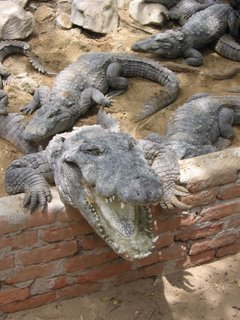
Wild!
The snake section of the Croc Bank has been set up and is maintained by the Irulas, a scheduled caste/tribal community that has historically lived quite separate lives from their neighbours in the forests of Tamil Nadu and who were primarily employed with snake and rat catching, and the hunting/gathering and sale of forest product (firewood, honey, beeswax etc.).
In 1976, the Indian Government signed the Forest Protection Act, which made their villages and livelihoods illegal. Since then, some terrible injustices have been made upon the Irula people as they have struggled to make a new way of life. Generations of some families have worked inside rice mills in slave labour and terrible conditions, while others have starved or died in desolation and hunger, and still others defy the government mandate and continue their traditional way of life in the forest.
In that context, Croc Bank, is an especially fascinating endeavour. In the snake venom extraction area of Croc Bank, you can witness the generations of expertise in working with deadly snakes, as they nonchalantly milk kraits of their venom (the process doesn't hurt the snake) or lift deadly cobras out of clay pots. "He bite, two days you die." the snake handler assured us as he held up the cobra and laid it gently on a platform in front of him. Withdrawing the home-made hooked tool he was lifting the snake with, he began to wave his bare hand in front of the cobra as it reared up and coiled it's hood, grinning wryly and unafraid as the gathered onlookers winced in fear.

He shows us several varieties of cobras and crakes, rejoicing in telling us how quickly the reptiles could kill us, while deftly manoeuvring his flesh just barely out of reach of the snake's fangs. The last one, the saw-scaled viper, a tiny little garter snake looking thing wrapped around his hand. He grins toothily as he says; "Just two hours. Two hours you die."
Like everywhere in India, if you just have a glimpse around a corner, there's a temple, and outside the snake venom extraction centre is no exception. There, a little tiled snake shrine, with freshly sandalwood and vermillion pasted carved cobra idols, and a small Ganesh to watch over the industrious endeavours of the park.
Of course, snakes aren't all you can see. The Croc Bank is home to more than a dozen species of endangered and non-endangered turtles, including soft shelled temple turtles who blend down into the sand at the bottom of their tanks,
and those that move so slowly that the algae that grows on their backs serve as an extremely slow moving buffet for the fish in their ecosystems.
We also saw komodo dragons and monitor lizards and at least a dozen varieties of crocodiles: caiman from the Amazon, American, and many local gharials and muggers. Each of the different areas had information signs up with a list of pictures that made up the diet of the croc in question, and you knew when you came across one with a picture of a bull, that you were dealing with a serious croc. The mugger is the biggest man-eating beast in all of India, and while they're kind of cute when they are babies:
Even if they do squirm a lot (and are capable of taking off your fingers if you put your hands in an inopportune spot!). But once they are all grown up, they are entirely deadly, and can jump, surprising distances. This full grown fellow, smelled meat in the air as one of the feeders came by and jumped up over the inner wall almost to the outer wall, making us all jump back and gasp as he came just inches from where he could have taken an arm off of us. Then he stayed around hanging out on the wall "mugging" his grin for the camera.
Wild!



0 Comments:
Post a Comment
<< Home